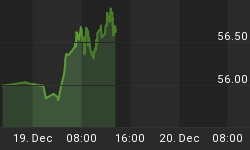Odds Favor Pullback vs. Ongoing Vertical Ascent
A common sense tenet of investing is assessing possible risk relative to the possible reward. As we have noted since January 24, the stock market's risk/reward ratio has entered unfavorable territory. When markets correct, it is typical to "retrace or give back" 38.2% of the recent gains. As shown below, if the stock market experienced a typical "give back", the S&P 500 could drop 63 points.

Since the November 2012 low, the S&P 500 has gained 166 points - a big move. From a risk/reward perspective, a fair question is "are the odds better for the S&P 500 to tack on another 63 points or do the odds favor the market giving back 63 points?" While we are not calling for a 63 point pullback, we believe the answer is the "63 point give back" is the higher probability outcome.
Cyclical Stocks Losing Momentum
According to the AMEX, the Morgan Stanley (MS) Cyclical Index:
"Is designed to measure the performance of economically sensitive industries within the U.S. economy and detect shifts in investor sentiment. The CYC Index comprises 30 stocks from over 25 industries, including automobiles, metals, papers, machinery, chemicals and transportation."
When the MS Cyclical Index is outperforming the broader market, it reflects optimism about the economy. When the index begins to lose steam relative to the S&P 500, it is indicative of slowing bullish momentum about future economic outcomes. As we explain in detail at the 6:28 mark of the video below, the MS Cyclical Index has been hinting at a possible reversal relative to the broader market, which in turn is concerning for stock bulls.
Below is an updated version of the MS Cyclical Index's performance relative to the S&P 500. Recently, reversals within the blue trend channel (see A1 & B1) have been followed by weakness in the S&P 500 (see above A2 & B2). If the pattern holds, the turn down this week below C1 hints at some corrective action in the stock market.

Fear Index Says "Be Careful"
The VIX is also known as the Fear Index. When the S&P 500 is outperforming the VIX, "risk-on" tends to be in fashion. Conversely, when the VIX begins to outperform stocks, the odds of entering a "risk-off" or corrective phase increase. As shown below, the S&P 500 relative to the VIX recently broke above resistance in a manner consistent with "risk-on". Since then, the breakout is beginning to look more like a "fake out". As of Thursday morning, the VIX has beaten the S&P 500 by roughly 10% this week, which raises a yellow flag for stock bulls.

The Battle of Inflation vs. Deflation
Stock market corrections tend to coincide with increasing concerns about future economic growth. Prolonged periods of economic weakness are deflationary events since waning demand causes asset prices to fall. When investors are more concerned about inflation vs. deflation, the ratio of silver (SLV) to Treasuries (TLT) tends to rise. When investors are more concerned about economic weakness and deflation, the ratio below tends to fall (see chart below).

With the Fed running the printing presses at breakneck speed, fears of inflation have had the upper hand in recent weeks. If the chart above breaks out to the upside, our concerns about a stock market correction would lessen. If the ratio begins to fall into the "Deflation Fears" area above, our concerns about stock prices would increase.
What Goes Up Can Come Down - Fast
As we noted January 25, when markets begin to advance in a near-vertical manner, it becomes more and more difficult to manage risk. Charts that "go straight up" can also "come straight down". If the NASDAQ breaks below the blue support lines shown below, a fairly quick drop back toward 3060 could be in the cards. Markets tend to fill "white space" on charts once bullish momentum deteriorates.

After noting an improving risk/reward profile on November 19, 2012, we began buying back stocks. Last week, as the risk/reward profile was becoming increasingly less favorable we booked profits in small-caps (IWM), transportation (IYT), mid-caps (MDY), emerging markets (EEM), technology (QQQ), and the broad market (SPY). The market can quickly erase gains that have taken months to accrue. By converting the gains to cash, they cannot be taken away by the market. Thus, with profits booked we are in better control relative to our next moves. If the market corrects, we can redeploy our profits at lower levels. If the market begins behaving in a more favorable manner, we can always buy back in when the risk/reward ratio is more favorable.
Could stocks continue to march higher in a straight line? Absolutely, positively yes, but it is not likely. We are not calling a top; just trying to invest prudently and protect our gains.















